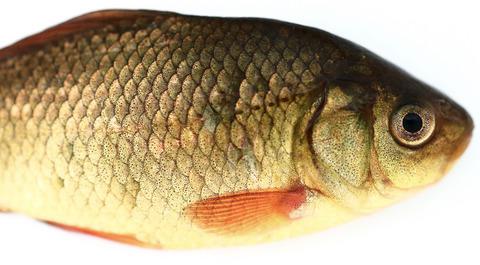当前位置:
X-MOL 学术
›
J. Anim. Ecol.
›
论文详情
Our official English website, www.x-mol.net, welcomes your
feedback! (Note: you will need to create a separate account there.)
More than meets the eye: predator‐induced pupil size plasticity in a teleost fish
Journal of Animal Ecology ( IF 3.5 ) Pub Date : 2020-08-16 , DOI: 10.1111/1365-2656.13303 Jerker Vinterstare 1 , Kaj Hulthén 1 , Dan E. Nilsson 2 , Per Anders Nilsson 1, 3 , Christer Brönmark 1
Journal of Animal Ecology ( IF 3.5 ) Pub Date : 2020-08-16 , DOI: 10.1111/1365-2656.13303 Jerker Vinterstare 1 , Kaj Hulthén 1 , Dan E. Nilsson 2 , Per Anders Nilsson 1, 3 , Christer Brönmark 1
Affiliation

|
Most animals are visually oriented, and their eyes provide their 'window to the world'. Eye size correlates positively with visual performance, because larger eyes can house larger pupils that increase photon catch and contrast discrimination, particularly under dim light, which have positive effects on behaviours that enhance fitness, including predator avoidance and foraging. Recent studies have linked predation risk to selection for larger eyes and pupils, and such changes should be of importance for the majority of teleost fishes as they have a pupil that is fixed in size (eyes lack a pupillary sphincter muscle) and, hence, do not respond to changes in light conditions. Here, we quantify eye and pupil size of individual crucian carp, a common freshwater fish, following controlled manipulations of perceived predation risk (presence/absence). We also tested if crucian carp responded to increased predation risk by shifts in diel activity patterns. We found that crucian carp show phenotypic plasticity with regards to pupil size, but not eye size, as pupil size increased when exposed to predators (pike). Predator-exposed crucian carp also shifted from diurnal to nocturnal activity. Using a modelling exercise, we moreover show that the plastically enlarged pupils significantly increase visual range, especially for small objects under dim light conditions. Overall, our results provide compelling evidence for predator-induced pupil enlargement resulting in enhanced visual capabilities in a teleost fish. Pupil size plasticity in combination with the observed shift towards nocturnal activity may allow for efficient foraging also under dark conditions when predation risk from diurnal and visually oriented predators is reduced. The data highlight the powerful role of predation risk for eye development and evolution.
中文翻译:

不仅仅是满足眼睛:捕食者诱导的硬骨鱼瞳孔大小可塑性
大多数动物都是以视觉为导向的,它们的眼睛是它们的“世界之窗”。眼睛大小与视觉表现呈正相关,因为大眼睛可以容纳更大的瞳孔,从而增加光子捕获和对比度辨别力,尤其是在昏暗的光线下,这对增强健康的行为(包括躲避捕食者和觅食)具有积极影响。最近的研究将捕食风险与选择更大的眼睛和瞳孔联系起来,这种变化对大多数硬骨鱼来说应该很重要,因为它们的瞳孔大小是固定的(眼睛没有瞳孔括约肌),因此,对光照条件的变化没有反应。在这里,我们量化了个体鲫鱼(一种常见的淡水鱼)的眼睛和瞳孔大小,在对感知到的捕食风险(存在/不存在)进行受控操作之后。我们还测试了鲫鱼是否通过昼夜活动模式的变化对增加的捕食风险做出反应。我们发现鲫鱼在瞳孔大小方面表现出表型可塑性,而不是眼睛大小,因为当暴露于捕食者(梭鱼)时瞳孔大小会增加。暴露于捕食者的鲫鱼也从白天活动转变为夜间活动。使用建模练习,我们还表明塑性放大的瞳孔显着增加了视觉范围,尤其是对于昏暗光线条件下的小物体。总的来说,我们的结果为捕食者引起的瞳孔扩大提供了令人信服的证据,从而增强了硬骨鱼的视觉能力。瞳孔大小可塑性与观察到的夜间活动转变相结合,可能允许在黑暗条件下也能有效觅食,当来自昼夜和视觉导向捕食者的捕食风险降低时。数据突出了捕食风险对眼睛发育和进化的强大作用。
更新日期:2020-08-16
中文翻译:

不仅仅是满足眼睛:捕食者诱导的硬骨鱼瞳孔大小可塑性
大多数动物都是以视觉为导向的,它们的眼睛是它们的“世界之窗”。眼睛大小与视觉表现呈正相关,因为大眼睛可以容纳更大的瞳孔,从而增加光子捕获和对比度辨别力,尤其是在昏暗的光线下,这对增强健康的行为(包括躲避捕食者和觅食)具有积极影响。最近的研究将捕食风险与选择更大的眼睛和瞳孔联系起来,这种变化对大多数硬骨鱼来说应该很重要,因为它们的瞳孔大小是固定的(眼睛没有瞳孔括约肌),因此,对光照条件的变化没有反应。在这里,我们量化了个体鲫鱼(一种常见的淡水鱼)的眼睛和瞳孔大小,在对感知到的捕食风险(存在/不存在)进行受控操作之后。我们还测试了鲫鱼是否通过昼夜活动模式的变化对增加的捕食风险做出反应。我们发现鲫鱼在瞳孔大小方面表现出表型可塑性,而不是眼睛大小,因为当暴露于捕食者(梭鱼)时瞳孔大小会增加。暴露于捕食者的鲫鱼也从白天活动转变为夜间活动。使用建模练习,我们还表明塑性放大的瞳孔显着增加了视觉范围,尤其是对于昏暗光线条件下的小物体。总的来说,我们的结果为捕食者引起的瞳孔扩大提供了令人信服的证据,从而增强了硬骨鱼的视觉能力。瞳孔大小可塑性与观察到的夜间活动转变相结合,可能允许在黑暗条件下也能有效觅食,当来自昼夜和视觉导向捕食者的捕食风险降低时。数据突出了捕食风险对眼睛发育和进化的强大作用。













































 京公网安备 11010802027423号
京公网安备 11010802027423号